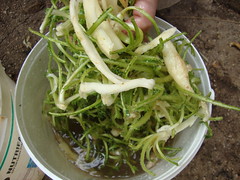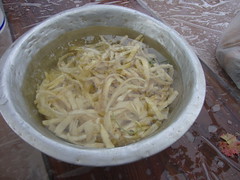It's icy cold now in the Cretan winter mornings. It often warms up a little in the day, but houses do not warm up in the winter sunshine. So every morning, we jump out of bed, throw on something warm to prevent the cold from seeping through our skins, wash ourselves quickly with icy water and warm up some breakfast. Two years ago, we would turn on the radaitors for a quarter of an hour to break the ice, in a manner of speaking, but now, we don't do that. It feels Dickensian here at times, but there's not much we can do about it except to grin and bear it.
These crisp mornings are nothing new to the locals. Rural Cretans have always been used to such conditions, perhaps not so much in recent times due to improved housing construction and heating methods, but homes were never kept warm all day in our recent past. But in our less recent past, ice was a prized item, 'harvested' for use as well as to make some money. In the same way that we nowadays try to find ways to create something to make money, my mountain-village ancestors tried to find things to sell to the town dwellers. One of the things that they sold to them was ice.
Even in the past, when people were more self-sufficient, they were never really completely self-sufficient. They were simply more self-sufficient than they are now because of the fewer opportunities to trade products, whether with goods or money. To make ends meet, they still had to engage in the some kind of bartering system, swapping goods that they had an excess of with goods that they did not have, with people who had them and needed/wanted their goods. For example, my grandfather from the mountain village of Kambi traded in ascrolimbri, a wild green that grows in specific microclimates and landscapes in Crete. This task involved foraging them, clearing them of dirt, peeling them to reduce excess weight and finally loading them onto the donkey for the ride into town. Ascrolimbi in those days were considered a delicacy in the same way that they are now. Not everyone has access to them, not then nor now, and they make a nice change to the daily diet. Although they look unusual, they are very tasty; both the leaf and root are eaten. They look similar to other greens found in the wild, but they are not the same ones, and the other greens are not edible.
Freezing and cold storage were known to my ancestors, even though they had no refrigerators or even electricity - the latter came in the 1970s in the mountain villages of Crete. The Lefka Ori mountain range is covered in snow throughout the winter. That snow looks as though it disappears by the end of June (or mid-July, as happened last year due to the heavy winter), but there are in fact pockets of ice remaining in places that are not visible from all vantage points. These ice-filled crevices were discovered by the villagers during their hiking, hunting and foraging expeditions. With their axes and picks, they carved out blocks and managed to take them into town to sell or exchange them for goods that they needed and could not produce in the mountains, eg sugar and rice.

Ice melts in the sun, but compa\ct ice can in fact last a while on a journey. Most of the villagers who walked from the mountains to the town for goods exchange would set off for the road to Hania at about midnight. So it would be cold and dark when the ice was being transported, and it would not melt away so quickly.

Walking or riding a donkey to Hania was always done in small groups of two or three people. There were no telephone lines then, but people had other ways to communicate with each other. Houses in the mountain villages were not very close to each other, but a small cluster would often be within view from each other. The time to set off for Hania would be arranged. Even if people didn't have clocks, they had ways of knowing what time it was, eg from the position of the moon or the stars. Then, at the pre-determined time, they would come out of their houses and wait for the signal to begin the journey.



Trading in ice stopped as early as it started. It was never really very feasible. It was difficult to carve out of the mountain, difficult to carry, difficult to transport and difficult to keep it from melting. But ice trading is similar to today's attempts to trade in natural or semi-processed elements with as little cost as possible and as much value added as necessary in order to make a small profit. Pretty soon though, technology catches up with the process and you need to move on to find something esle to trade in. Fashions come and go, and so is the case in natural products. These days the buzzwords in Greece are 'extra-virgin' and 'green energy'. But for how long? Somebody somewhere else has already found cheaper ways to procure these elements - there's a bit of άρπα κόλλα να προλάβεις everywhere in the marketing world these days.
©All Rights Reserved/Organically cooked. No part of this blog may be reproduced and/or copied by any means without prior consent from Maria Verivaki.
 |
| Mist, fog, smoke, smog - the closer you are to the sea and mountains, the thicker it is. It's hard to work out if the wood-fires are to blame or if it;s just the weather phenomena; humidity is a regular feature of the Cretan climate. |
Even in the past, when people were more self-sufficient, they were never really completely self-sufficient. They were simply more self-sufficient than they are now because of the fewer opportunities to trade products, whether with goods or money. To make ends meet, they still had to engage in the some kind of bartering system, swapping goods that they had an excess of with goods that they did not have, with people who had them and needed/wanted their goods. For example, my grandfather from the mountain village of Kambi traded in ascrolimbri, a wild green that grows in specific microclimates and landscapes in Crete. This task involved foraging them, clearing them of dirt, peeling them to reduce excess weight and finally loading them onto the donkey for the ride into town. Ascrolimbi in those days were considered a delicacy in the same way that they are now. Not everyone has access to them, not then nor now, and they make a nice change to the daily diet. Although they look unusual, they are very tasty; both the leaf and root are eaten. They look similar to other greens found in the wild, but they are not the same ones, and the other greens are not edible.
Pappou never cleaned the ascrolimbi, but if he did, he could have commanded higher prices.
Freezing and cold storage were known to my ancestors, even though they had no refrigerators or even electricity - the latter came in the 1970s in the mountain villages of Crete. The Lefka Ori mountain range is covered in snow throughout the winter. That snow looks as though it disappears by the end of June (or mid-July, as happened last year due to the heavy winter), but there are in fact pockets of ice remaining in places that are not visible from all vantage points. These ice-filled crevices were discovered by the villagers during their hiking, hunting and foraging expeditions. With their axes and picks, they carved out blocks and managed to take them into town to sell or exchange them for goods that they needed and could not produce in the mountains, eg sugar and rice.

An ice-skating rink is erected in Hania by the stadium every year during hte Christmas period.

Snow on Lefka Ori

The skating rink
My grandmother would swing a lit lamp from a vantage point where she could see the other house and her neighbour would be able to see her. The neighbour would then swing back her lantern. There were no street lights, so it was pitch dark throughout the night. Only the moon and stars offered any lighting, if they were visible on a clear night. The only light visible on the ground would be that which came from those lamps. And with the signal exchange complete, they would start their journey. The journey to Hania took about 4-5 hours, with a couple of stops for the animals (and the people) to rest, taken in clearings off the road. The villagers would arrive in time for early morning trading at the Agora, while the donkey rested and was fed/watered. Riding back up the mountain was always more difficult. If it was raining, you still had to set off to go back home, because you had nowhere to stay in the town. The animals needed to rest more often up the hill - they were always laden on both legs of the journey.

Although snow is rare on low ground in Hania, it has been known to happen (photos from December 2010).
Trading in ice stopped as early as it started. It was never really very feasible. It was difficult to carve out of the mountain, difficult to carry, difficult to transport and difficult to keep it from melting. But ice trading is similar to today's attempts to trade in natural or semi-processed elements with as little cost as possible and as much value added as necessary in order to make a small profit. Pretty soon though, technology catches up with the process and you need to move on to find something esle to trade in. Fashions come and go, and so is the case in natural products. These days the buzzwords in Greece are 'extra-virgin' and 'green energy'. But for how long? Somebody somewhere else has already found cheaper ways to procure these elements - there's a bit of άρπα κόλλα να προλάβεις everywhere in the marketing world these days.
©All Rights Reserved/Organically cooked. No part of this blog may be reproduced and/or copied by any means without prior consent from Maria Verivaki.



I can't imagine how difficult their journey had to be. And, to not have a clock to wake up? Given the amount of physical work most people had to do back then, how did anyone ever wake up on time? The preservation of their lifestyle is so necessary. Great post Maria.
ReplyDelete